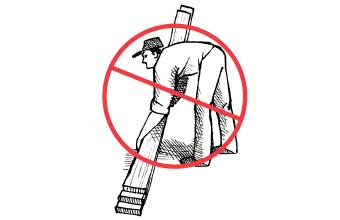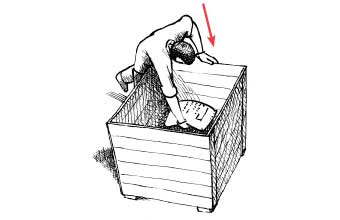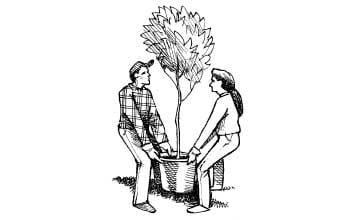Key Points:
- Establish a wide base of support before picking up a load.
- Use your shoulders to help support a lightweight, odd-sized load.
- Ask for help if you can’t safely lift or move a load by yourself.
Back injuries can be costly
If you’ve ever hurt your back, you know how painful it can be. Back injuries can result in lost work time, costly medical bills, long-term chronic pain, and decreased quality of life. Improper lifting is a common cause of back injuries. Each pound of weight you lift puts close to 7 1/2 pounds of pressure on your lower back. While you may be familiar with some of the standard “safe lifting” tips, it’s not always possible to follow them when you need to pick up a large but lightweight box of cotton, a piece of lumber, a long pipe, or another odd-sized load.
Lifting odd-sized loads:
- The general rule of safe lifting is to carry the load as close to your body as you can, but this is not always possible, depending on the size and configuration of the load.
- An alternate way to lift odd-sized, lightweight objects is to carefully lift the object up to your shoulder and support it on your shoulder while you move it. If the object is long, keep the front end higher than the rear and never block your field of vision.
- Before you pick up the load, be sure you:
- Establish a wide base of support by parting your feet. Put one foot slightly in front of you and the other slightly back.
- Straighten your back, then squat to pick up the load, keeping your back straight the entire time. You'll know you have a good base of support if your front foot heel remains on the ground or floor.
- Remember to use your legs to help you lift.
Managing difficult to reach loads:
- There are times when you can’t lift perfectly, no matter how hard you try.
- One example is when you need to reach into a bin, container, or other storage area.
- In these situations, you can use the assisted one-hand lift.
- Rest your non-lifting hand on top of the container
- Bend over to grasp the object, then push down with your hand that's on top of the container to force your upper body back to a vertical position.
- Be sure to let your non-lifting hand - not your back - do the work.
- Only use this type of lift if the object can be grasped with one hand and it is not too awkward or heavy.
More safe lifting tips:
- Avoid overreaching. If you must pick up an object higher than shoulder level, use portable stairs or a height-adjustable platform if possible. Slide the object as close to you as you can.
- Use your arms and legs to help you lift rather than your back. Keep your back straight.
- Never bend from the waist to pick up any type of load.
- Ask for help if an object is heavier than you can safely lift alone. Even if an object is lightweight but bulky, it may be better to get a co-worker to help you move it. It’s especially important to get help with odd-sized loads because your center of gravity can easily be displaced.
- When moving a long object with a co-worker, be sure each person supports the object with the same shoulder, and that both people keep in step.
- Avoid twisting your body while lifting or carrying a load.
- Plan ahead before you move a load. Be sure you have a clear path and know where you are going to set the object down.
Lifting Awkward Loads Do’s and Don’ts
Do
- Establish a wide base of support before picking up an odd-sized load.
- Be sure your front foot heel remains on the floor or ground when you squat down.
- Ask for help if a load is too heavy or bulky to handle alone.
Don't
- Overreach to pick up a load.
- Lift if you are in poor physical shape.
- Bend from the waist to pick up a load.










